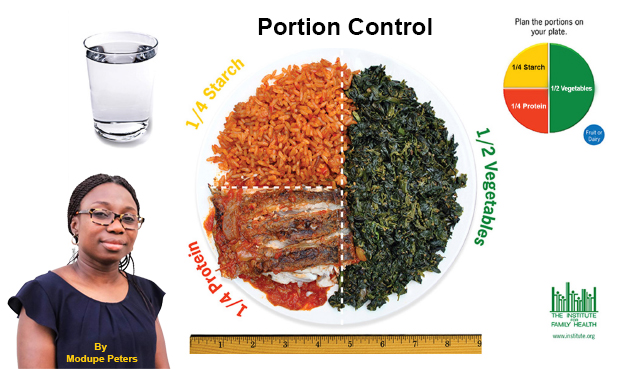Help! I Have Diabetes (Part 2)
As ever, we encourage you to be proactive about your health. Diabetes can be a serious condition, but with good management it can be controlled.
Diet is fundamental in the treatment of the two main types of diabetes-Type 1 and Type 2. Carbohydrates (carbs) are our main source of glucose for energy. Foods that contain carbs also provide essential nutrients for good health. All the carbs we eat and drink are broken down into glucose which helps our brain and nervous system to function properly.
The amount of carbohydrate ingested determines the rise in blood glucose level, and how quickly the rise will be is dependent on the type of carbohydrate (glycaemic index –GI). This is why it is important for people with diabetes to be aware of the sources of carbs in their diet, the amount, and the type they eat.
Carbohydrates
There are two main types:
• Starch:
Examples are bread, cassava, cereal, grains, yam, sweet potato/potato, rice, fufu, pounded yam, kenkey, plantain, etc. They form the basis of our meals, therefore controlling portions at meal times help to better regulate our blood glucose level. In Type 1 diabetes, carbohydrate counting is used to better match the amount of carbs eaten, and insulin injected at meal times.

• Sugars:
This can be divided into ‘naturally occurring’ and ‘free’ (or added sugar).
Naturally occurring: Examples include those found in fruits (fructose), milk and yoghurt (lactose).
Free (added sugar): They are found in sweets, chocolate, sugary drinks and desserts, other examples could be those found in condensed milk.
What is Glycaemic Index (GI)?
Glycaemic Index is a rating of how various carbohydrate foods can raise blood levels quickly, moderately or slowly. Different foods rich in carbohydrate are digested at different rates, therefore, the GI rates how quickly each carb containing food and drink triggers the blood glucose level to rise after eating them.
The GI rating is between 1-100. The lower the number, the slower the digestion and absorption of the glucose in the blood. Foods that are digested slowly would raise blood glucose at a much steadier rate.
The slower absorbed carbs are termed; low GI foods. Examples include most fruits and vegetables including lentils/pulses, wholegrain bread, wholewheat pasta and sweet potato. High GI foods would include foods like white bread, corn flakes or sugar coated or chocolate cereals and sugary drinks like fruit juices.
Research has shown that choosing these low GI foods can help manage long term blood glucose levels (HbA1c) in people with diabetes especially in Type 2 Diabetes. These foods are also better options for general health whether or not you have diabetes. Not all low GI foods are healthy choices though; chocolates and cakes for example have low GI because of their fat content which slows down the digestion and absorption of carbohydrate.

Type 1 Diabetes:
Carb counting is key to management of type 1, this involves matching amount of carbs at meal time with insulin, this allows for more flexibility. A number of structured education programmes are available to teach these essential skills i.e. DAFNE (Dose Adjustment For Normal Eating).
Type 2 Diabetes:
People with Type 2 Diabetes need to be carb aware, so portion size control is quite essential not just for regulating blood glucose levels but also for weight loss.
• Portion size guide for weight loss: Aim for half plate to be vegetables/salad and the remaining half plate to be split between protein foods i.e. meat/fish and half for starchy carbs.
Weight loss is crucial to the management of blood glucose in overweight or obese people with Type 2 Diabetes. Reducing overall calorie intake and increasing activity levels are the best ways of losing weight healthily and keeping it off for good.
Some healthy eating tips:
• Aim to eat regularly. Have breakfast, lunch and dinner each day. Space these meals out over the day.
• Include a form of starchy carbohydrate at each meal, they help to provide energy for the body and are also rich in B-vitamins which help release energy from food. Choose wholegrain/wholewheat varieties and control portions.
• Aim for at least 5 portions of fruits and vegetables each day; they are rich in fibre, low in fat and calories and also provide vitamins and minerals for the body, a portion is equivalent to a small handful of fruit (80g) and about 3 heaped tablespoons of beans and pulses/vegetables.
• Aim for at least 2 portions of oily fish such as mackerel, salmon, pilchards per week.
• Cut down on fat especially saturated fats (i.e. palm oil, butter, full fat milk, cheese, evaporated milk), reducing overall fat will help with weight loss. Grill, steam or bake instead of frying.
• Limit intake of sugar and sugary foods.
What we feed our body determines how it will function. Balancing this with spiritual food is also important. As Christians we must remember that our bodies need to be well looked after and treated as the temple of the Most High so we can function for His will and purpose.

Modupe Peters is Diabetes Specialist Dietitian & director a Food for Purpose


